How to Minimize Home Damage from Expansive Soils
Home » Structural »
Expansive soils swell when wet and shrink when they dry. In most years they will cause damage to more homes in the United States than earthquakes, floods hurricanes and tornadoes collectively. Unfortunately homeowner insurance policies do not cover damage from expansive soils.
As strange as it may sound, the first consideration in determining whether a house is structural sound is based on what kind of soils the home is built on and whether they’re any “Geotechnical” problems.
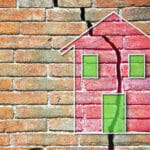
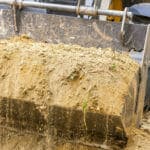

Home Owners and Buyers
- What are expansive soils
- How to know if you have expansive soils
- Sources of moisture
- Why expansive soils cause damage
- Signs of expansive soils
- How to be pro-active ; Mitigation of moisture issues
25% of all homes in the United States experience cracking or damage due to expansive soils
In the US it is estimated that over one-half of all homes are built on soils that that are unstable or have issues and that half of these homes will experience some form of damage or structural issues. Basically 1 out of 4 homes is subject to some level of damage accordingly to the Society of Civil Engineers. Fortunately the majority of these issues can be reduced or avoided by the owner being proactive
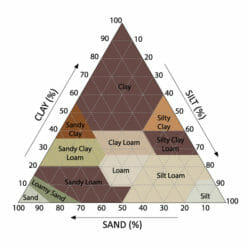
1. What are expansive soils
Expansive soils are soils that are characterized by the presence of swelling clay minerals that can absorb a significant amount of water molecules. It is a soil that is susceptible to to large volume changes of swelling and shrinking that are directly related to changes in the water content.
- When expansive soils gain moisture they expand or swell up
- When expansive soils lose moisture they shrink or lose volume
How to know if expansive soils
There are various sources to help you determine if your area has expansive soils.
- Geological maps that cover the entire US, as well as state and local maps that show the soil characteristics of your area.
- The physical appearance of the soil.
- At time there may be a gap between the foundation and the soil that has pulled away from foundation. This gap might be a 1/2 inch or maybe an 1 1/2 inch wide.
- The local building department will often be able to address the soil composition in your area.
- A geologist, soil engineer, excavation contractors and other professionals will generally have information on the local soils.
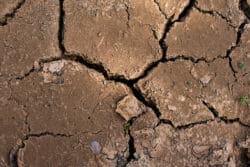
You may or may not see cracks in expansive soils
Varies types of expansive soils expand at different volume ratios. When the soils are wet or during a rainy season, you may not see any cracks and when the soils are dry, such as in hot seasons or hot climate areas you may see cracks.
The cracks will often have a polygonal pattern and may be shallow to deep and in extreme conditions may reach 30 feet deep. The photo is of cracking in soils with a high clay content.
Sources of moisture
- Down spouts discharging near foundation
- Poor drainage
- Rain and storms
- Leaking water lines or sewer lines
- Pool near the house leaking (if a pool do bucket test to check for leaks)
- High water table Or under ground streams
2. Why expansive soils cause damage
If a foundation moves or becomes damaged, then the structure on top of the foundation may suffer damage. The damage may range from a few minor cracks or problems to costly and serious structural issues.
- In some areas expansive soils can do significant damage to a foundation because there are types of expansive soils that may exert an uplifting pressure as high as 5,500 (PSF) pounds per square foot on the foundation. This can easily crack or damage a foundation.
- Can expand soil upward under a foundation as much as 6 or 8 inches. This will cause floors to slope as well as a host of other problems with a home.
- Expansive soils may raise one side or one end of a home but not the other.
Overly wet clay soil
If clayey soils become overly wet and gets a consistency near that of mud, it then looses much of its ability to carry the weight of the foundation and house. Just as when when you walk through a muddy area, your feet sink down into the mud; a house does the same thing if the clayey soil gets too wet. Therefore, having the grading around the home designed so that the rain water runoff dissipates quickly is very important.
Seasonal changes and sprinkler systems
Seasons changes often bring about wet and dry periods where the soil may be wet for months and then dry for months resulting in the foundation or slab being lifted up or heaved up for the wet season and then dropping down or shrinking down for months. These seasonal cycles of up and down movement (heaving and shrinking) damages the concrete, a brittle material and not flexible in nature. Now continue this over the years and it is easy to see how damage occurs.
Another thing that happens is that each time the foundation rises up and then drops back down, it does not fully drop down to its original location, thus its raised just a little higher than it was in the last cycle. Secondly the entire foundation doesn’t drop down evenly, but has high and low areas resulting in the foundation sloping or tilting in some areas or cracking due to the stress from uneven soil support.
Uneven movement (non-uniform movement) can also be caused by differential swelling due to pockets of moist soil next to areas of dry soil. Sprinkler system, planters or landscaping difference may contribute to this. If a home has a tropical landscaping at one end that requires a lot of water and a desert type landscaping at the other end, then the elevation at one end may be an inch or more different than the other end.
Different areas of foundation may experience more movement than others. Corners are one of those areas, for at a corner there is less weight bearing down on the foundation than at other areas. If a corner area has less weight, then it is easier for expansive soils to lift up the corner area and crack or bow the foundation.
Older houses have more foundation movement than newer homes
Older home usually will have more evidence or damage due to movement than newer homes. Older homes:
- Exposed to more seasonal cycles than newer homes
- Changes in landscaping may have changed the grading around the home
- Footings and foundations in newer homes are better engineered for soil conditions
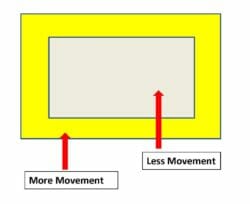
Slabs and basement walls
Homes built on concrete slabs generally experience more movement on the first 5 feet or so of the perimeter areas than the more interior areas of the slab. Less moisture penetrates to the interior portions of the slab.
Basement walls will frequently have cracking, which can lead to moisture intrusion through the walls. Expansive soils can damage the walls just as it does footings; therefore keeping moisture away from the house is wise.
3. Signs of expansive soils
There are a number of yellow or red flags that your home may be having issues that relate directly or indirectly to expansive soils.
- Cracked foundation or basement walls
- Soil pulled back from foundation in dry seasons
- Sloping floors
- Spongy floors
- Doors and windows that rub or stick
- Self-closing or opening doors
- Gaps at top, bottom or side of doors
- Garage door gaps at bottom corners
- Drywall cracks / some will open and close seasonally
- Stucco cracks
- Brick veneer on exterior cracking
- Roof sags or wavy
Note that some of these warning signs may be from other issues than expansive soils.
4. Mitigation of moisture problems
Homeowners or buyers can avoid or minimize damage from expansive soils through managing the moisture content of the soils.
Avoiding damage – Things that can help
- Have gutters and down spouts
- Planters next to the foundation need watering to be very controlled
- A/C condensate line should not discharge next to foundation
- Sprinkler systems should be timed and not over watered
- Landscaping, jungle lush tropical v desert landscaping
- Trees and subsidence (Read about)
- Drainage should be away from the house
- Neighbor draining onto property near one side of your house
- Foundation watering systems
In various areas of Texas or other states that have soils with a very high clay content there are home owners who may have a sprinkler system that is separate from their main sprinkler system that only waters the areas near the homes’ perimeter foundation. They may have .a drip system set 18 to 24 inches out from the foundation set on a timer or even tied into a soil moisture meter that turns on the drip system when the soil moisture drops below a certain point. Other home owners may lay out a soaker hose around their foundation and manually turn it on and off.
The reason for doing this is to keep the moisture content of the soil around the foundation constant, avoiding very dry and wet cycles that create swelling and shrinkage of the soil.

Bottom Line
Engineers, inspectors and contractors often bring into a conversation “expansive soils” when discussing soil movement, structural issues, cracking and foundation problems. The reason being is that in construction and in a home’s structural soundness expansive soils can play a major role.
A structural check. Once every year or two take a look around your house, both inside and outside, for evidence of potential issues that may relate to expansive soils. Check for “red or yellow flags,” for they may be early warning signs of future problems.
Be proactive. It is better to do things around the home now that will avoid or reduce future damage resulting from expansive soils.

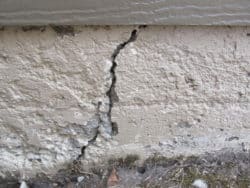
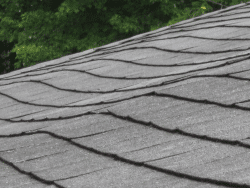

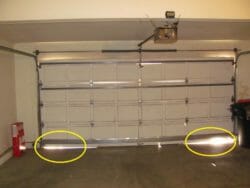
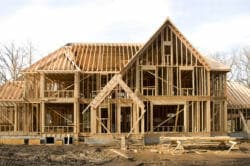




how to repair already happened cracks or damages